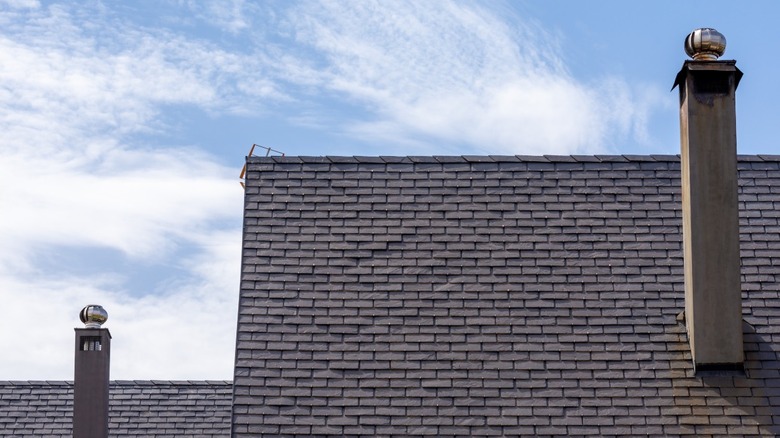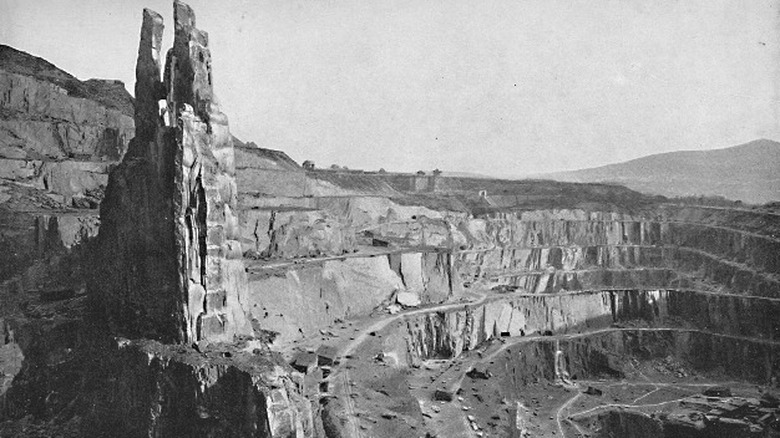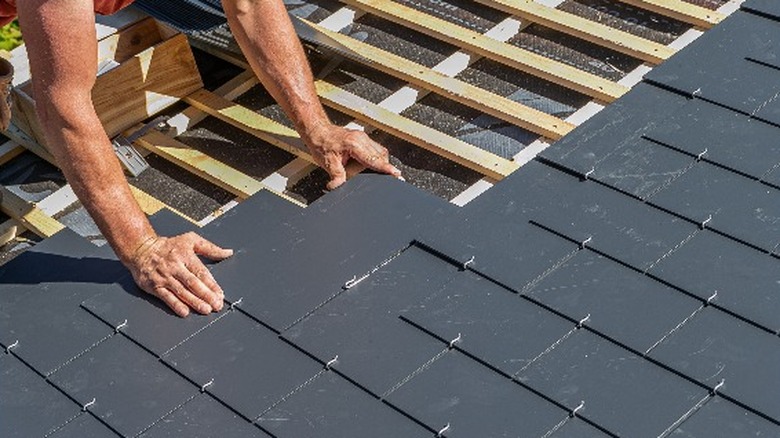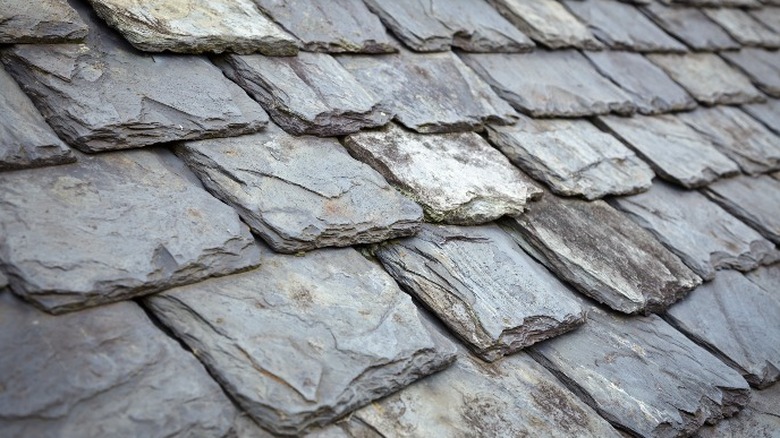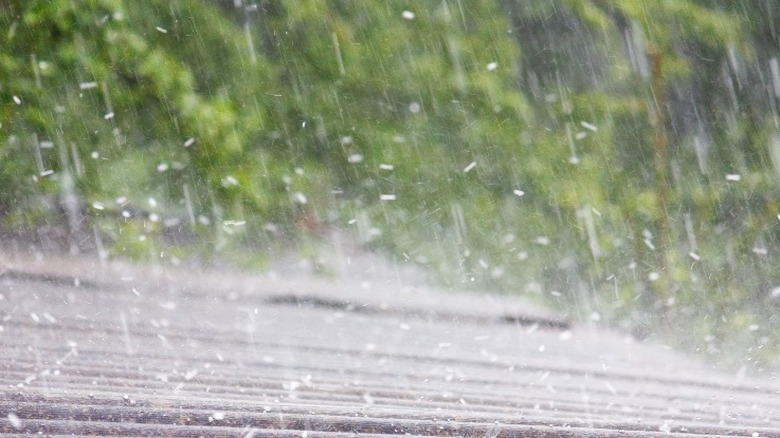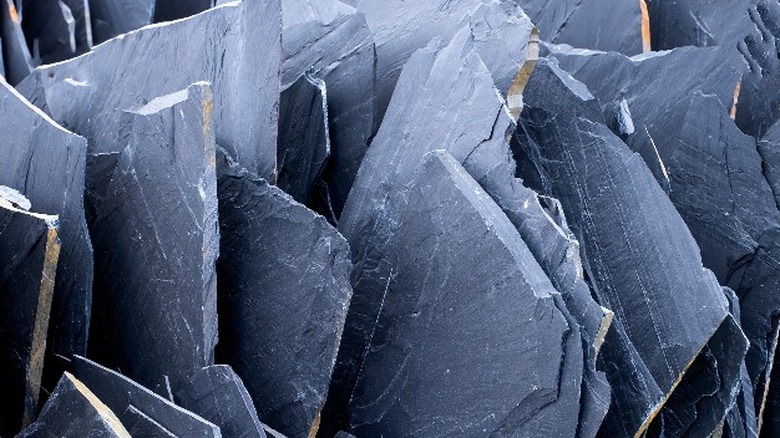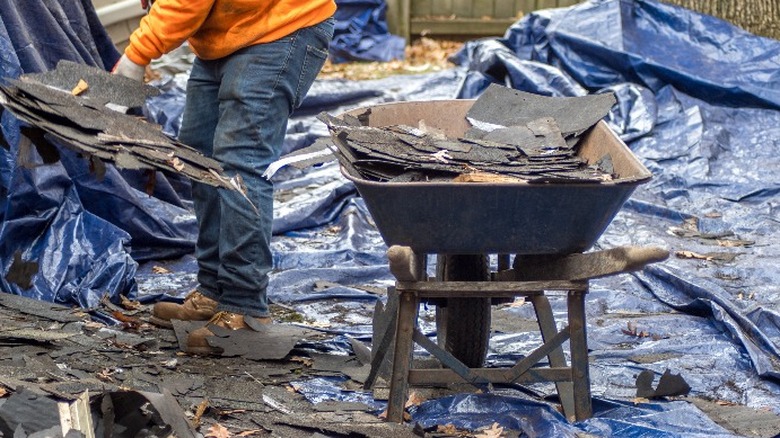What To Know Before You Buy A Slate Roof
Slate has been used a traditional roofing material throughout the world for centuries, and it is gaining popularity again in modern times. Natural slate is a metamorphic rock that forms over millions of years from shale deep below the earth's surface, from where it is eventually extracted in large rock quarries, as Vermont Slate Co describes. Its composition is multi-layered, so it is easily split into sheets and then cut into the shingles seen now on both historic and modern buildings. This tried-and-tested material has a strong reputation for its durability, providing excellent protection from all types of weather, pests, and other issues that commonly plague homeowners. The beautiful, natural stone is among the highest quality in roofing materials, and is an excellent investment for anyone thinking in the long term.
When thinking of purchasing any type of roof, it is important to weigh practical considerations such as cost, value, and upkeep. Aesthetic features, such as beauty, tradition, and historical significance should also be factored in. Slate roofs undoubtedly have unique characteristics that make them better suited for some situations than others. Continue reading below to find out if a slate roof is the best option for your particular needs.
The history of slate roofs
Slate roofs in the United States date back as far as the mid-17th century, well before the start of the American Revolution. Slate was originally imported to America from Europe, until the first slate quarry opened in Pennsylvania in 1785, according to the National Park Service. Domestic production slowly made slate more accessible to the general population, but the material was not widely used for roofing until almost a century later. Production peaked at the turn of the 20th century, with the expansion of railroads and over 200 slate quarries in operation. At this time, the U.S. was also exporting slate to other nations, in a reversal of the material's origins. By 1915, however, the slate roofing industry fell into decline and the stone lost favor to other materials that were easier and less expensive to mass-produce and ship across the country.
Slate is quarried primarily from the Northeast region of the country, and certain areas are known for different colors. Quarries in Maine, Pennsylvania, and Virginia produce deep blue-black hues, and greens, purples, and reds are typically found in Vermont and New York. The variations are a result of the mineral composition of the rock. For example, slate quarried from Virginia has a glossy sheen due to high levels of mica, and the exceptionally rare red slate from New York gets its color from iron compounds.
Now that slate roofs are again growing in popularity, The National Park Service urges people to properly educate themselves on the history, proper installation, and maintenance of slate roofs, so that their practical benefits and historical significance can be preserved for many years to come.
What are the parts of a slate roof?
Slate roofs consist of more than just the stone itself. All parts of your roof should be made of high-quality materials, and installed correctly by an experienced, reputable roofer. Slate roofs require specific tools, training, and skill, so it's best to do adequate research before hiring an installation or repair company.
The underlayment covers the roof deck and sits below the slate shingles. The type of underlayment will vary depending on the roof material that is installed above it, and the climate considerations specific to your area. Some types of underlayment have ice and water guards, but these additional protections are not necessary for a slate roof. Instead, slate roofers use traditional organic roofing felt, meant to protect the roof deck during installation but then disintegrates within two to three years. The Washington Post explains that if installed correctly, the slate shingles alone should provide adequate moisture control and protection from the elements.
Metal flashing provides additional protection on joints and openings of a roof structure. Copper is the best choice for metal flashing in slate roofs, as it does not corrode like other metals. Copper flashing will last about 60 years, and thus it may need to be replaced earlier than the slate shingles themselves. Additionally, the types of nails used are important. Whether copper, stainless steel, or galvanized, the nails should have a life-span similar to that of the slate, and won't quickly rust or corrode. As with the metal flashing, copper is the preferred material. The National Slate Association advises that the nails should be long enough to puncture the sheathing, but not over-driven so they penetrate through the other side. Setting the nails incorrectly, or using the wrong kind can damage the slate and lead to future problems.
Types of slate roofs
Graduated slate roofs are the most traditional type, the method dating back to earliest use. Before modern stone cutting techniques were developed, slate quarries produced shingles of varying sizes. The National Slate Association explains that a roofer would begin their process by sorting all the pieces by size and shape. During install, they would be arranged so that the smallest pieces lay at the top, and the largest, heaviest shingles were placed at the bottom of the roof, where the underlying structure is strongest.
Standard slate roofs are also known as uniform slate roofs due to their consistent appearance. The shingles are all the same length, width, and thickness, cut square and evenly spaced to create a clean look and easy installation. These are the most common type of slate roof seen in the United States. Additionally, random-width slate roofs are similar to standard slate roofs. They are uniform in shingle length and thickness to maintain neat rows, but vary in width to create an offset, slightly irregular pattern.
A staggered-butt slate roof is made up of random-length shingles that hang down to overlap the top of the next row laid beneath them, explains North Face Construction. A ragged-butt slate roof is similar, but the bottom of the shingles are angled or irregular rather than squared off, adding even more texture and visual interest.
Textural slate roofs have the roughest appearance of those mentioned. The shingles have a rough, hand-hewn appearance, and vary in thickness to emphasize the texture of the stone. The resulting composition is unique to the individual structure. Slate also varies in color, ranging from green to the more common blue-black, and even purples and reds. This opened up a myriad of possible patterns and designs for homeowners to make a unique statement.
Pros and cons of a slate roof
The best way to decide if you should buy a slate roof is to weigh the pros and cons. There are several important factors to consider.
Pros:
Slate roofs have a natural, subdued aesthetic, and are especially appropriate for classic or historic homes. Slate roofs are incredibly durable, lasting up to 150 years if installed correctly, according to Home Advisor. The stone surface repels water, helping to keep moisture issues such as fungus, mold, and rot at bay. Slate is strong enough to withstand wind, snow, sleet, hail and heavy rain, and provides an impenetrable barrier against damage-causing insects and other unwanted pests. Slate is also fireproof, offering protection from stray sparks that could ignite a house fire. Slate is also a sustainable roofing option, as both its production and durability contribute to its lessened environmental impact.
Cons:
The biggest obstacle for potential buyers is the high cost of slate roofs. Both materials and installation are relatively expensive compared to other roof options, though costs do vary depending on location and other factors. Slate is also very heavy, weighing significantly more than the average composite shingle, The Spruce warns. If the structure of your home is not equipped to hold the weight of a slate roof, you may either have to seek other options, or invest in additional structural support before the first slate tile is ever installed. Finally, while slate roofs should require little maintenance, it can be difficult and expensive to find an available contractor with the necessary skills and experience. If slate isn't the best choice for your home, read on to learn about synthetic options that capture the aesthetic of natural slate at a lower price point.
Natural slate vs. synthetic slate
As technology has advanced, manufacturers have developed synthetic slate shingles modeled after the real thing. They can be made of asphalt or recycled rubber or plastic, and are designed to mimic the aesthetic of natural slate with artificial stone texture and chisel marks for a handcrafted feel.
Compared to natural slate, the greatest advantage of using synthetic slate is the lower cost. According to Bill Ragan Roofing Company, synthetic slate costs about $10 to $20 per square foot, whereas natural slate starts at $15 and can reach $30 per square foot. With a large roof, that difference can really add up!
Another cost-saving advantage of synthetic slate is that it is easier to install than natural slate, which requires specific tools and methods by a roofer specifically trained in slate installation. By comparison, synthetic slate is a far more modern material, and the necessary tools and installation methods are more commonly used and familiar to qualified roofing companies. Synthetic slate shingles are also much lighter than natural stone, and therefore more versatile and practical in several cases.
Synthetic slate does have its drawbacks as well; for one, it has about half the expected lifespan of natural slate. Manufacturing of synthetic slate shingles also varies in material and quality, and with any new material, it can be harder to predict factors such as durability or aesthetics over time. Regardless of which you choose, both synthetic slate and natural slate can increase the value of your home and help you achieve a classic look.
Potential cost savings of a slate roof
Slate is among the more expensive roofing options for your home, but with it comes certain benefits that can make it an excellent investment for the right homeowner. The first and most obvious advantage is that it can increase the overall value of your home. If installed and maintained correctly, slate roofs can last well over a century, making it an attractive option for individuals hoping to pass their property onto future generations. Its incredible longevity means fewer repairs and repeated installation costs, which can add up over the years. There's also the peace of mind that comes with knowing your roof will last as long as you plan to enjoy your home.
Beyond monetary cost, slate roofs save on costs that come at the expense of the natural environment. Residential construction produces a significant amount of material waste, most of which ends up in landfills. By choosing a slate roof, you're also choosing a sustainable option that is better for the environment in both the short term, and over time. As a natural material, slate has a relatively low production impact, and installation requires no synthetic materials such as adhesives that can introduce toxic chemicals into the environment, per Sela Roofing. Due to their longevity, slate roofs produce far less material waste than less durable options that must be replaced every 20 to 30 years. Slate even has a lessened impact at the end of its life cycle; according to The Durable Slate Company, slate shingles can be reused and recycled after serving their initial purpose, unlike most asphalt and synthetic roof materials that are discarded to landfills. A slate roof is a substantial investment, but its greatest value is in helping to preserve the planet in your lifetime, and beyond.
